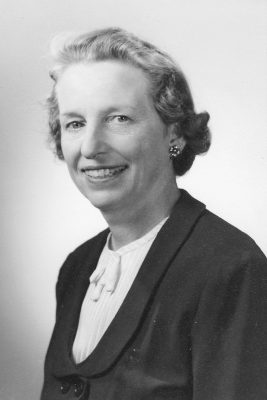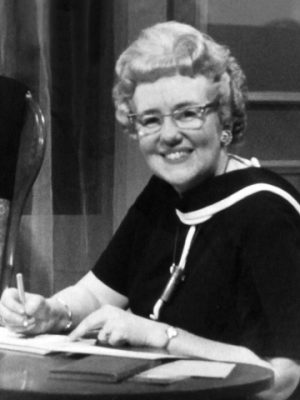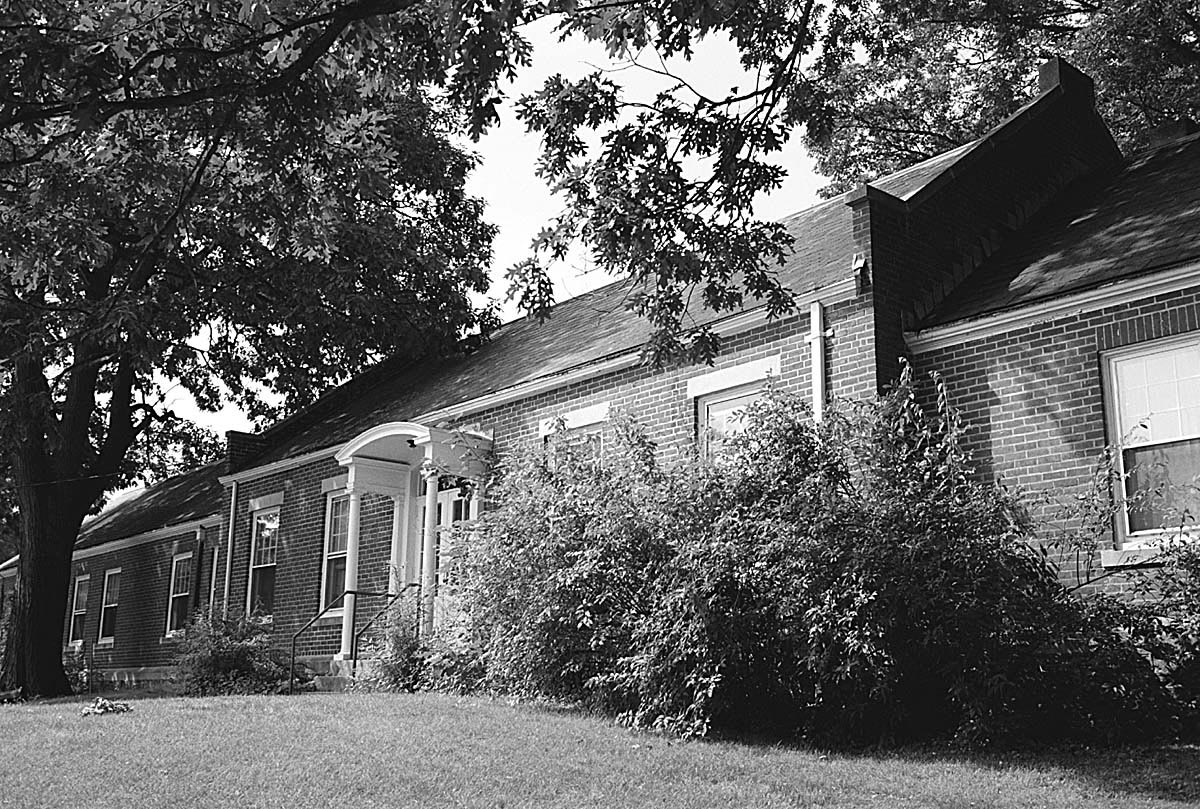
80 Years
of Nursing Excellence
For over three quarters of a century, the University of Connecticut School of Nursing has prepared professional nurses who have gone on to provide leadership at state, national, and international levels.
The School of Nursing was the first public institution in Connecticut to offer a program leading to a bachelor’s degree in nursing, and in the fall of 1942, thirteen students were the first to be enrolled into the newly established UConn School of Nursing. Other hallmarks of the School’s development include the establishment of the master’s degree program in 1971 and the establishment of the doctoral degree program in 1994.
Our Founders
Carolyn Ladd Widmer

A Phi Beta Kappa Wellesley College and Yale University School of Nursing graduate, Carolyn Ladd Widmer served as the School’s first dean from 1942 to 1967. Prior to her arrival at UConn, she was the founding director of the School of Nursing at the American University of Beirut. During Widmer’s tenure, UConn was rated in the top 25% of the nation’s schools of nursing in a 1949 survey performed by the National Committee for the Improvement of Nursing Services.
In 2020, Eric Widmer wrote and published a loving memoir of his mother, "Nursing a Life: A Remembrance of Carolyn Ladd Widmer, 1902-1991." To order, visit ethelwalker.org/everywomanpress.
Josephine A. Dolan

The appointment of the School’s first-full time instructor, Josephine A. Dolan, in 1944, was of great importance. Dolan’s revision of “Goodnow’s History of Nursing” appeared in 1953 and became “Dolan's History of Nursing,” and then later “Nursing in Society.” She was a national authority on the history of nursing and her revisions earned her two honorary doctorates, as well as the Connecticut Nurses’ Association establishment of an award in her honor for outstanding contributions to nursing education.
Building and Archives
 Completed in 1919 at a cost of $47,732.42, the Widmer Building was the University of Connecticut’s first infirmary. A substantial building, it contained an open ward for patients, several private rooms, office space, and a large solarium with a fireplace. Located next to Swan Lake, then called Duck Pond, the infirmary was surrounded by a grove of tall trees until a hurricane destroyed many of them.
Completed in 1919 at a cost of $47,732.42, the Widmer Building was the University of Connecticut’s first infirmary. A substantial building, it contained an open ward for patients, several private rooms, office space, and a large solarium with a fireplace. Located next to Swan Lake, then called Duck Pond, the infirmary was surrounded by a grove of tall trees until a hurricane destroyed many of them.
The School of Nursing first occupied the Widmer Building, also known as “the cottage,” in 1950 when the present-day infirmary was opened. Conversion of the old infirmary’s open ward into a classroom, and the private rooms into offices, made the space suitable for academic purposes. The new accommodations also provided the expanding School with much-appreciated relief after almost a decade of being in confined quarters in the Home Economics building, which is now known as the Design and Resource Management building.
From the mid-1950s until the 1968-69 academic year, the building was shared with the School of Physical Therapy, with one wing of the building assigned to each school. The basement served as a combined library and conference room, and a small adjoining area contained hydrotherapy facilities and a men’s shower and locker room. Additional renovations in the late 1960s further modified the building’s interior to meet academic needs.
Now named Storrs Hall, the building has been declared a historic landmark. In 2011, the building began construction on the Widmer Wing, which includes an atrium, auditorium, and our Clinical Simulation Learning Center. It was dedicated to the School’s founding dean in 2012, and the auditorium was named after alumna Margaret E. “Peggy” Sczesny in 2019.
Through the Years
1940s and ’50s
Initially the School of Nursing’s curriculum was five years in length. Students in the first class were also enrolled in the U.S. Cadet Nurse Corps, a federal program within the U.S. Public Health Service, designed to increase the number of nurses needed overseas during World War II. One member of that pioneer class later became the first director of the Division of Nursing at Southern Connecticut State (College) University. In accord with national trends, in 1953 the UConn program was shortened from five to four calendar years. Equal time was devoted to nursing and non-nursing coursework at that time.
The UConn School of Nursing Alumni and Friends Society, established early in the School’s history as separate from the UConn Alumni Association, performed a great deal of tasks for the School. The society financed student delegate trips to national conventions, donated money for the purchase of materials pertaining to nursing history, established the Carolyn Ladd Widmer Scholarship to provide emergency financial aid to students in need, planned and conducted the ceremonies celebrating the tenth, fifteenth, twenty-fifth, and fiftieth anniversaries of the School of Nursing, and established a program of speaking about nursing careers in high schools around the state.
1950s and ’60s
Following Dean Widmer, Eleanor K. Gill led the school from 1967 until her retirement in 1980. In December 1970, the School of Nursing initiated and organized interdisciplinary team activities among the faculty and students from the health professional schools of Nursing, Allied Health, Dentistry, Medicine, Pharmacy, Social Work, and Nutritional Science. These efforts resulted in the implementation of a new curriculum that advocated a joint effort of health schools in training nursing students. The combination of medical specialties in the establishment of interdisciplinary courses facilitated and enhanced the effectiveness of teaching and learning nursing, ultimately bettering the rendering of health care.
In 1955, the Mu chapter of Sigma Theta Tau, the International Honor Society of Nursing, was chartered at the University of Connecticut.
A survey of graduates conducted in 1966 revealed that alumni of the UConn School of Nursing held a broad array of national and international positions. The variety of jobs included the Peace Corps, armed forces, nursing service settings, academic institutions, and religious orders. One graduate of the Class of 1948 had been awarded the Bronze Star Medal for meritorious service rendered during the Korean Conflict.
1970s
In 1971 the first class was admitted to the School of Nursing’s Master of Science program, designed to prepare nurse educators and master clinicians, and later, nurse managers. Two graduates of that decade later completed doctoral studies and went on to become deans of schools of nursing, one at St. Joseph College and one at her alma mater, the University of Connecticut.
Up until the mid-1970s, many School of Nursing students had to traverse the state in order to fulfill their nursing curriculum. Originally, Storrs, Hartford, New Haven, Greenwich, Norwich, and Middletown composed the multiple areas of teaching. In 1975, the Faculty White Papers decided the destiny of the School by setting forth their desire to have Storrs as the location of the entire faculty, student body, and physical resources. This step, taken by the faculty, not only strengthened the ties between students and faculty, but also centralized the School of Nursing’s curriculum at Storrs.
1980s and ’90s
Marlene F. Kramer was dean of the School from 1980 to 1987, expanding its research mission and revising the curricula for undergraduate and graduate programs. Under her leadership, the alumni society became an important force in the life of the School.
Beverly Koerner was dean from 1988 to 1993. In 1991, the School of Nursing building was renamed the Carolyn Ladd Widmer Building in honor of the School’s first dean. That same year, the School’s Center for Nursing Research was founded, and the University acquired the professional book collection of renowned nurse leader Virginia A. Henderson, thereby enhancing the research resources for both students and faculty.
In 1992, the School’s 50th anniversary was marked by the dedication of a room in Storrs Hall honoring Josephine A. Dolan, professor emeritus and renowned nurse historian, who had been a School of Nursing faculty member for 35 years. Three years later, she donated a valuable collection of papers, creating a designated history of nursing collection in the new Dodd Research Center.
2000s and 2010s
The School made significant advances in nursing education throughout the 2000s, with the integration of interactive patient simulation manikins in the on-campus simulation lab and the inauguration of full-semester clinical education abroad programs in Cape Town, South Africa, and San Juan, Puerto Rico.
The School began its Doctor of Nursing Practice program to develop advanced clinical practice, institutional leadership, and policy analysis. The 11-month post-baccalaureate program, the Master’s Entry into Nursing (now Certificate Entry into Nursing, or CEIN), began and quickly expanded the nursing workforce. Deans Laura Dzurec and Anne Bavier led these visionary innovations in nursing education and research.
The School expanded its interdisciplinary and interprofessional teaching and research through strategic faculty hiring in the fields of medicine, education, biostatistics, technical communication, and nutrition science.
In 2012, the 15,000-square-foot Widmer Wing addition to the School’s existing space in Storrs Hall opened its doors. The addition includes state-of-the-art classroom and laboratory facilities, including high-tech simulation technologies. The School celebrated its 75th anniversary in 2017, marking the occasion with a gala for alumni, donors, faculty, and staff.
By 2019, the School of Nursing had over 600 pre-licensure students in more than 700 contracted clinical sites, over 130 master’s degree students in five specialty areas, and almost 100 doctoral students in the Ph.D. and DNP programs. Under the leadership of Dean Regina Cusson, Dean Carol Polifroni, and former Dean Deborah Chyun, the School of Nursing engages advanced interdisciplinary research through its Center for Advancement in Managing Pain and Biobehavioral Laboratory. Other research strengths include neonatal, infant, and maternal care; diabetes care; and geriatric care.
2010- 2024
The UConn School of Nursing now resides in Augustus Storrs Hall with the attached Widmer Wing, which includes an atrium, auditorium, and our Clinical Simulation Learning Center. It was dedicated to the school’s founding dean in 2012, and the auditorium was named after alumna Margaret E. “Peggy” Sczesny in 2019. With a newly constructed Simulation Center, the school hosts the largest incoming School of Nursing Class for 2028 of 222 undergraduate students under the current Dean Victoria Vaughan Dickson, PhD, RN, FAHA, FHFSA, FAAN.
The Future of UConn Nursing
The School of Nursing Building project is currently in the Planning Phase with design anticipated to complete in June 2024, followed by bidding. The new facility will feature flexible spaces to allow for different setups for various learning modalities and lecture halls to accommodate large gatherings, and will maximize space for student learning through simulations, training, lectures, and studying.
Construction is anticipated to begin in November 2024 and complete in 2026. The groundbreaking for the new building will take place on October 3oth, 2024. More information for the Future of UConn Nursing can be found here: https://nursing.uconn.edu/building-the-future-of-nursing/
